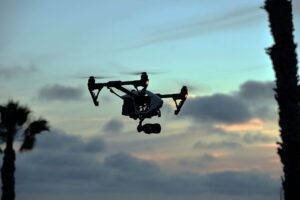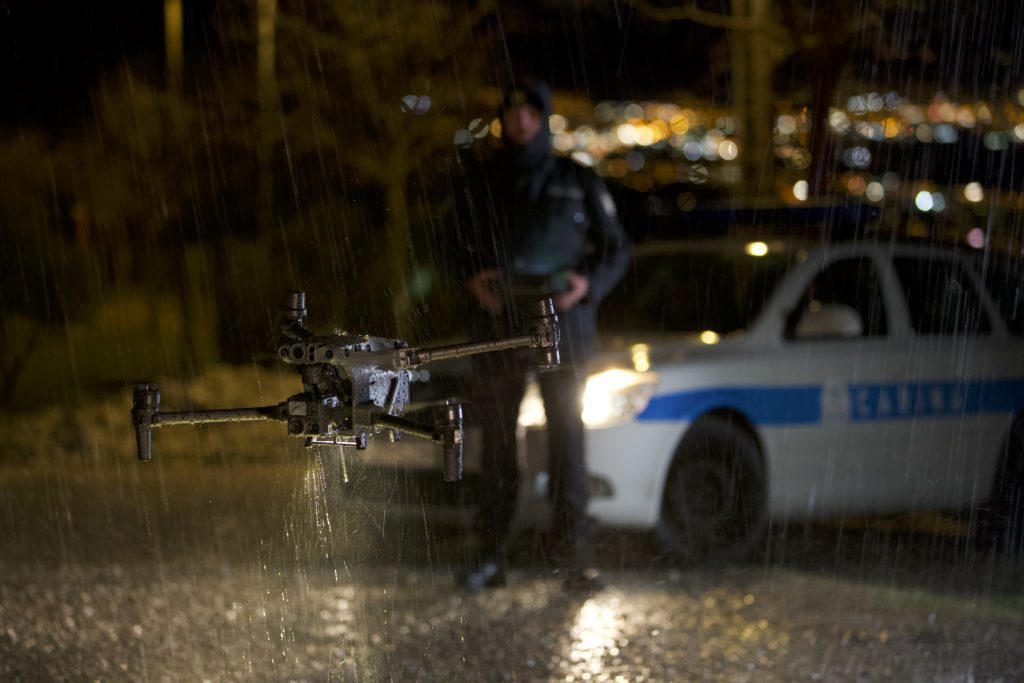

The American Drone Security Act, included in the FY 24 National Defense Authorization Act, would limit the use of federal funds for drones on a “covered list” which includes all drones manufactured in China. Bathrick’s presentation focused on the practical impacts that the Act has for public safety agencies.
Effective Immediately: Purchasing Drones Manufactured by “Covered Entities” with Federal Funds
Effective immediately, federal agencies are prohibited from purchasing drones manufactured in China (subject to some exemptions or a waiver process.) The prohibition is for purchase with federal dollars: recreational flyers, private sector companies not working with federal customers, or (see below) state and local agencies not using federal dollars are not subject to the regulation.

What’s a Chinese drone? The Question of “Associated Elements”
Functioning drone systems involve controllers, hardware, payloads, and more. One of the critical open issues in interpretation of the Act is what exactly is covered. The Federal Acquisition Security Council (FASC) has responsibility for determining exactly what’s prohibited. While the ADSA refers to “associated elements” – i.e., payloads – a referenceable list of those associated elements has not been completed.
What About Operations of Chinese Drones?
The Act refers to both the purchase of new drones – effective immediately – and a prohibition of operation of Chinese drones, which has a 2 year timeframe for implementation. After 2025, there are exemptions – and some loopholes.
Federal agencies including DHS, DOD, DOS, DOI are exempt under certain circumstances. The wording of the Act leaves some loopholes, with a list of exempt operations OR the provision “that the subject UAS cannot transfer to or download data from a covered entity,” which could leave the agency some options on technology choices. Other agencies such as DOT and FAA, NTSB, and NOAA are exempt from the Act for specific operations.
Waivers are also an option – but are not designed to be easy. Waivers can only be applied for on a case-by-case basis and must come from the head of agency authority: waivers must be approved by OMB after consultation with FARC and require notification to lawmakers.
Federal ASDA-Compliant Strategies
Bathrick says that there are several strategies that federal agencies can use to implement drone technology: all of them have drawbacks but offer some options.
- Waivers
- Blue UAS – DOD sponsored program, limited access for manufacturers
- Green UAS – AUVSI sponsored programs, costs for manufacturers
- Agency-Qualified Non-Covered
- Drone and Data as a Service – outsourcing the issue
- Other programs – utilizing other federal employment programs
Advice for State and Local Public Safety Agencies
In the absence of state laws, the ADSA does not directly impact state and local public safety agencies unless they are utilizing federal funds to procure their drone hardware. Bathrick says that first and foremost, it’s important for agencies to educate their leadership about the issues.
“Security is important,” says Bathrick. “Support for the US industry is important, and they both deserve tailored solutions.” Bathrick urges agencies to avoid “lazy” requirements: but to look into the specifics of what will work for their operations.
Agencies can also strategize to adjust federal grant vs. state and local funding strategies, for more flexibility.
And to protect programs and operations, says Bathrick, it’s critical to continue to communicate with stakeholders and communities. Bathrick recommends that agencies prioritize programs to educate officials with public safety program results, briefings on your mission risk profile, and “defense in depth” security strategies.
Read more:
- Exclusive Interview: DJI Officials Defend Data Security Policies Amid Chinese Drone Ban Concerns
- Controversy Surrounding Data Security of Chinese-made Drones Sparks Intense Debate
- CISA Issues Guidance on Chinese-Manufactured UAS, AUVSI Urges Action
- FY 24 National Defense Authorization Act Includes American Security Drone Act, Limiting Chinese-Made Drone Use
Miriam McNabb is the Editor-in-Chief of DRONELIFE and CEO of JobForDrones, a professional drone services marketplace, and a fascinated observer of the emerging drone industry and the regulatory environment for drones. Miriam has penned over 3,000 articles focused on the commercial drone space and is an international speaker and recognized figure in the industry. Miriam has a degree from the University of Chicago and over 20 years of experience in high tech sales and marketing for new technologies.
For drone industry consulting or writing, Email Miriam.
TWITTER:@spaldingbarker
Subscribe to DroneLife here.
